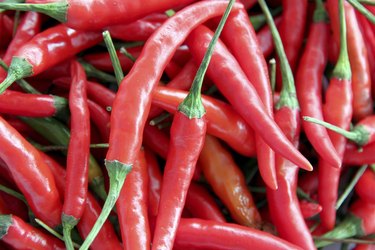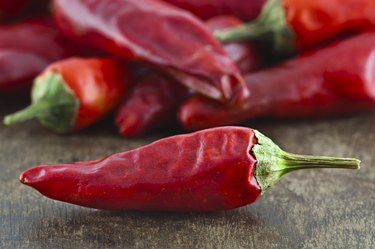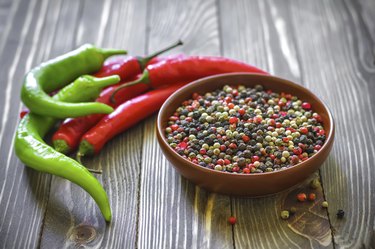
The local gardening center usually has a display of charming red pepper (Capsicum annuum) plants bursting with red droplets against green foliage and perfect for creative holiday decorating. Turn that holiday décor into a useful cooking supplement by knowing when to pick cayenne peppers, whether from an indoor plant or outside in the garden. Identify the best timing by the look of the maturing peppers. Every stage of growth determines the intensity of heat the pepper produces, so your tolerance for the heat dictates at which stage you harvest. Peppers picked early, before turning bright red, are more tangy and less sweet.
Tip
Picking mature cayenne peppers can be harmful if you rub your eyes with fingers that haven’t been protected against the capsicum the peppers produce. Wear surgical or gardening gloves for safety and harvest before the peppers fall off the plant.
Video of the Day
Hot Climate, Hot Peppers
Have you ever noticed that the hotter the climate, the spicier the native food is? There's a reason for that. Because meat and other proteins spoil more quickly in the heat and before refrigeration, societies needed to protect themselves from rotting foods. Spices have antimicrobial and antiparasitic properties and mask the taste that goes along with spoiling meat. Spices also promote sweating, and in a tropical climate, perspiration is a cooling factor for the body. They trigger the metabolism that increases body temperature to promote sweating. While people don't always like to eat much when hot and humid weather moves in, spices stimulate the appetite, which helps maintain health.
Video of the Day
Cayenne pepper originated in the Cayenne region of French Guiana and is now grown mostly in India, East Africa, Mexico and the United States. Chilis as a whole have their roots in South America. This "new world" pepper, cayenne, spread its popularity to Europe via the Spanish and Portuguese explorers.
When to Pick Cayenne Peppers
If you are growing your peppers outside or in a container, the harvest usually occurs from 90 – 100 days after planting, usually in mid-summer. The intensity of color and look of the skin of the pepper tells you if they are ready to come off the plant. The red of the pepper should be intense and the skins waxy. Check for firmness, as a mushy pepper is an overmature pepper. You can harvest the peppers when they are green but the flavor is less intense.

The more you harvest, the more new chilis appear. Use a sharp secateur and cut gently. You don't want to pull, as that may damage the plant itself and curtail further pepper production. Once some peppers start turning bright red, check the plants frequently and remove the fruits as they mature. Be sure all peppers are plucked before the first frost moves in.
Uses for Cayenne Peppers
Once you've picked your cayenne peppers, you can chop them for use in sauces. Or, string them together and hang the string for several weeks until they are dry. To make pepper flakes, put several dried peppers in a grinder and whirl until they reach the consistency you want. To make pepper powder, continue to whirl until they are reduced to a fine powder. Whatever your choice, store in a cool, dry place. And be sure your eyes are protected when you remove the dust from the grinder!

A dash of cayenne enhances many dishes. It adds a punch to any fish or shellfish presentation, and just a pinch of cayenne turns a Hollandaise sauce into a diner's delight. Any mild-tasting culinary creation can be enhanced with just a touch of cayenne. Just go easy with it until you reach the intensity that satisfies your palate.